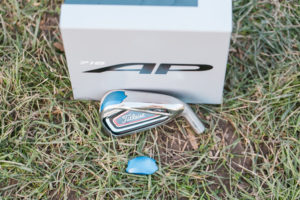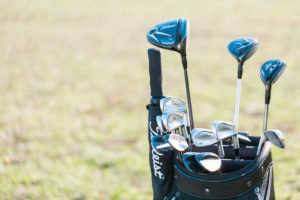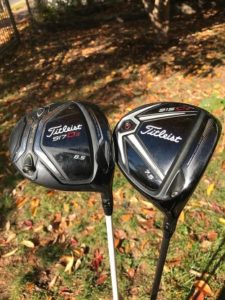Clubhead Comparison: Titleist C16 vs. TMB vs. 716 AP1
Why Do This Test:
There has been huge advancements in recent years leading to irons that launch the ball farther and farther. For Titleist, huge strides were made not only in forgiveness to the 716 AP1 vs. its 714 predecessor, but it also got a very noticeable distance upgrade.
Check out how the 716 AP1 stacks up against the 716 AP2 right HERE
In the fall of 2015 Titleist also released a new iron, called the 716 T-MB. This club is an extension of the 712u and was born as a long iron replacement that is more forgiving as a blade, and longer than AP2. Simply put T-MB has been a dark-horse option with consumers as well as some of the worlds best that compete on the PGA Tour. Adam Scott has one in his bag and Jordan Spieth won with one last week at Colonial.
And then there is C16. For the first time Titleist has released a very limited, very technologically advanced, very expensive iron that they are calling the “highest-launching, longest and most forgiving players irons we’ve ever constructed.”
Let the distance battle begin!
Clubs Used/ Specs:
Club 1: Titleist C16 7 iron, Dynamic Gold X100 shaft, all specs standard
See the full specs HERE
Club 2: Titleist 716 T-MB 7 iron, Dynamic Gold X100 shaft, all specs standard
See the full specs HERE
Club 3: Titleist 716 AP1 7 iron, Dynamic Gold X100 shaft, all specs standard
See the full specs HERE
Golf Ball: Titleist ProV1x
Launch Monitor: Trackman 3e
The Numbers:
The below table shows the average numbers for each data point for each club. I hit about 10 shots with each club.
The Blue 9 iron is a C16 7 iron
The Yellow 8 iron is a TMB 7 iron
The White 7 iron is a AP1 7 iron (ALL CLUBS WERE STOCK 7 IRONS)
The Results:
AP1 carried 4.4 yards farther than C16 and 9.2 yards farther than T-MB
C16 carried 4.8 yards farther than T-MB
AP1 had the lowest launch angle at 18.7*, 0.7* lower than C16, and 2.9* lower than T-MB
AP1 had the lowest spin rate at 6812 RPM, 854 lower than C16, and 1425 lower than T-MB
For comparison purposes, below are PGA Tour averages, according to Trackman.
Explanation:
Since this was a Distance Test, I will focus on the main factors that affect carry distance… Launch angle, spin rate, club head speed, and ball speed. AP1 had the lowest launch, but by a wide margin it had the lowest spin rate. This is what led to the distance results I saw. I hit the ball very high, with higher than average spin rates for the most part. This lower spin rate enabled the golf ball to penetrate more through the air and achieve maximum carry. Moreover, I averaged only 3 yards of roll-out with the AP1, which is still extremely playable. Surprisingly my swing speed with the AP1 was the lowest by about 1.5 MPH, but the ball speeds were virtually identical with all 3 clubs.
So, why on earth did I hit the AP1 so much better than these other two, highly innovative and technologically advanced irons? The answer has to do with lofts and Center of Gravity. The C16 and AP1 have identical lofts, at 31* for the 7 iron, but the C16 has a lower CG (center of gravity). The lower the CG the higher the ball with fly, and with more spin. The T-MB has a similar CG to C16, but its loft is 33*. This is the reason why the T-MB, for me, flew extremely high with excess spin, resulting in shorter carry distance. Interestingly enough I actually averaged a half yard of backspin with the T-MB (which is no good). Bottom line if you are swinging at speeds similar to mine and faster than the tour averages in the chart above, clubs that have an extremely low CG will most likely not work out for you. If you swinging at more moderate to slower swing speeds, there is no question the T-MB and C16 irons are capable of longer distances than the AP1. This is why it is vital to get properly fit from a knowledgeable club fitter with access to a wide range of fitting components and an accurate launch monitor. A prime example would be to look at the current PGA Tour players that have or are currently playing a full set of T-MB irons. To my knowledge, Jason Bohn, Ben Crane, Peter Malnati and Tim Clark have at one point or are currently playing a complete set of T-MB, and none of them are bombers to say the least. Each of these players’ average driving distances this year on TOUR are sub- 280 with none of them cracking the top 170 in the rankings. The lower CG this club provides simply produces the best launch conditions for them.
Which Clubs You Should Go With:
AP1:
- You are looking for maximum distance and/or maximum forgiveness.
- Rarely attempt to shape the ball around objects or towards targets.
- Have a steep angle of attack and a wider sole will assist with heavy shots.
- Feel/feedback isn’t the first priority in choosing an iron.
T-MB:
- You prefer the look of a blade
- You currently play AP2 but could benefit from a few more yards
- You could benefit from a higher launch
C16:
- You are looking for the longest and most forgiving players iron
- You desire an iron that has ultra-premium materials and state-of-the-art technologies
Conclusion:
During this test between C16, TMB, AP1, the results I saw were honestly not all that surprising to me. All 3 irons are extremely forgiving for their size, but there is no covering up the benefits the 716 AP1 can provide to a wide range of players and swing speeds. My recommendation is to keep your mind open, and as always, get properly fit. This might sound crazy but my 2* strong 716 CB might be getting replaced with the AP1 next season. Look out!
Thank you for reading. Please comment below and tell me what clubs/ shafts/ balls you would like to be tested head to head.I will choose the most popular requests and post results ASAP.
You might also wanna check Titleist SureFit Tour Hosel & Performance Fitting Chart.
Comments:
Hi there! I simply would like to give an enormous thumbs up for the nice info you may have .Power Data Recovery



